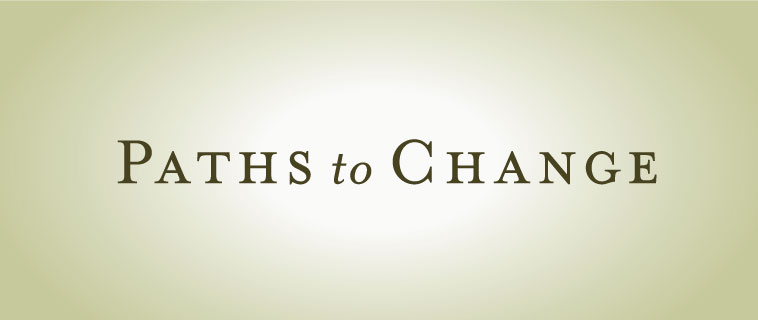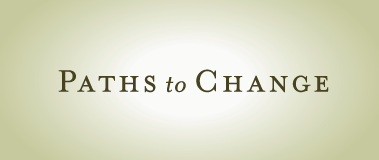What do our clients say? Access client testimonials here.
Some teams and organizations enjoy long periods of relative calm and stability. The reality is, though, that for many, change is a constant.
In a world of regular fluxes of ecological, economic, political, social and other forces, many of our clients speak of “living in a world of permanent white water.” Navigating this “white water” of change is often an epic challenge.
Whether you’re experiencing more moderate change to achieve a desired future state — or whether you’re living in a world in which “VUCA” (Volatility, Uncertainty, Complexity & Ambiguity) is the new normal — it’s essential to know which approaches, tools and practices will best guide you to your desired future state, and which will land you in a quagmire.
At Paths to Change, we support our clients with both conventional visioning methods, and non-conventional and emerging-futures methods.
Conventional Visioning Methods
With conventional visioning methods, a leader or leadership team might use left-brain and right-brain practices to develop a compelling vision, and then deliver it to stakeholders in a way that inspires, engages and enrolls. This vision might guide the collective for months or years.
In other cases, a leader or leadership team might engage the collective in developing the vision — through gathering input, or perhaps building consensus, or even delegating the visioning activity and outcomes. Then they translate the vision into strategic and tactical plans — integrated with work processes, structures, systems, and more — and implement it.
Non-Conventional and Emerging-Futures Methods
Increasingly, our clients come to us for non-conventional or emerging-futures methods. While conventional visioning methods are well suited to situations characterized by stability, cohesion and predictability, they are not well suited to worlds of dynamic change, uncertainty and complexity.
In fact, using conventional approaches in complex situations is generally one way to ensure failure.
Instead, we use a range of leading-edge practices, tailored to each client’s specific situation.
In some cases, it is appropriate to use scenario planning: determine a few key drivers of possible futures, generate a small set of possible futures based on those drivers, and select the most likely scenario(s) — then develop strategy and tactics accordingly.
When clients face immense uncertainty about their future positioning, markets, customers or more, we support them in mapping out a complex future terrain, and in creating multiple robust adaptive strategies — with the necessary structures, systems, staffing and other integral aspects — to navigate the terrain.
In yet other cases, we help clients presence their team or organizational DNA — their core collective success and sabotage patterns — and build towards an emerging future based on the current collective patterns.
Hear from our clients
A sampling of testimonials from clients, below, speaks to our work with Emerging Futures.
We welcome the opportunity to support you in realizing your desired future state.
Sample Client Testimonials
“The stakes were high –including lives and property in disaster relief efforts… ARCBA was, and remains, one of the best disaster relief agencies in the world. Nonetheless, … some of ARCBA’s shortcomings concerned me. Lawrence and Keith were central to turning around this situation…. They convened a wide cross-section of ARCBA stakeholders to optimize our future… Very few of us had been exposed to those kinds of processes. They were very innovative, and they had us deeply engaged from the very start… The outcomes were stellar.”
– Greg Smith, Former Chair of the Board, American Red Cross of the Bay Area (ARCBA)
See full testimonial here.
““The work of … Theory U is woven throughout our Fellowship… to attune to and co-create emerging futures… Lawrence is outstanding at powerfully weaving together mindfulness, emerging futures and sustainability… It is rare for a single individual to be able to command the respect and attention of such senior leaders across so diverse a range of topics. Through his expert knowledge, his consummate instruction and skillfulness, he sets our yearlong Fellowship up for amazing success.”
– Greg Ranstrom, Fellowship Director, American Leadership Forum – Silicon Valley
See full testimonial here.
“Lawrence, Jidan, Michael and Susan (all working through InPartnership Consulting, a sibling firm to Paths To Change) used a range of innovative techniques (Advanced Scenario Planning, Open Space Technology, Conversation Café and more) that allowed us as leaders to envision realistic future possibilities, align on the most likely scenarios, and generate strategies and actions to benefit the impacted communities. Their repertoire of futures approaches was formidable; their preparation of the group to use non-conventional techniques that were completely new to most group members was gentle, yet rigorous; and their overall facilitation and consulting were masterful.”
– Carla Dartis, Former Senior Vice President, Tides, Inc.
See full testimonial here.

